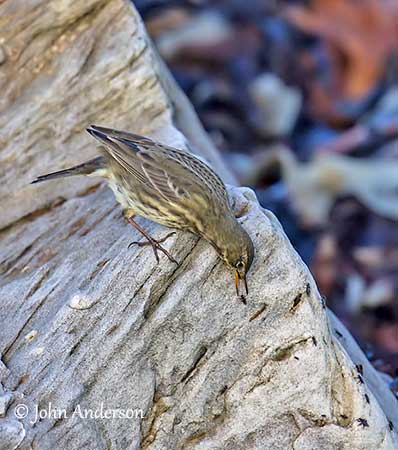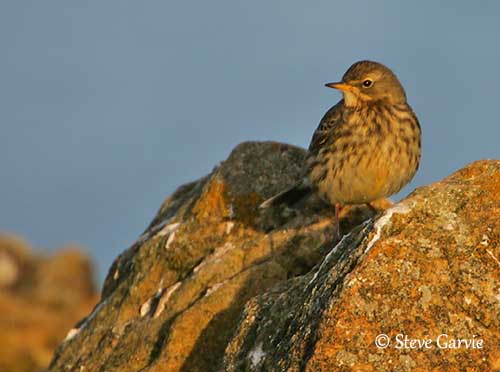
Fr: Pipit maritime
Ang: Eurasian Rock Pipit
All: Strandpieper
Esp: Bisbita Costero
Ita: Spioncello montano
Nd: Oeverpieper
Sd: Skärpiplärka
Photographers:
John Anderson
John Anderson Photo Galleries
Photo de Steve Garvie
RAINBIRDER Photo galleries & Flickr Rainbirder
Text by Nicole Bouglouan
Sources:
HANDBOOK OF THE BIRDS OF THE WORLD Vol 9 - by Josep del Hoyo - Andrew Elliot - David Christie - Lynx Edicions - ISBN: 8487334695
THE HANDBOOK OF BIRD IDENTIFICATION FOR EUROPE AND THE WESTERN PALEARCTIC by Mark Beaman, Steve Madge - C. Helm - ISBN: 0713639601
THE COMPLETE BOOK OF BRITISH BIRDS – Written by “Royal Society for the Protection of Birds” experts - Préface de Magnus Magnusson - Michael Cady- Rob Hume Editors - ISBN: 0749509112
L’ENCYCLOPEDIE MONDIALE DES OISEAUX - Dr Christopher M. Perrins - BORDAS - ISBN: 2040185607
Wikipedia, the free encyclopaedia
Home page
Page Passeriformes Order
Eurasian Rock Pipit
Anthus petrosus
Passeriformes Order – Motacillidae Family
INTRODUCTION:
The Eurasian Rock Pipit is almost exclusively a coastal bird. It feeds in rocks at the foot of cliffs, among algae and shore’s vegetation. It often breeds close to the shoreline in rocky crevices or on islands. Its cryptic plumage makes it almost invisible.
During winter, it can be seen sometimes near freshwater inland lakes. Outside the breeding season, they gather around abundant food sources. They are usually resident, and only perform short movements.

DESCRIPTION OF THE BIRD:
Biometrics:
Length: 17 cm
Weight: 18-32 g
The Eurasian Rock Pipit is mostly a large, stocky-bodied bird.
The adult of nominate race has dark olive-grey upperparts with indistinct dark streaks on mantle, whereas the rump is olive and less streaked. The wings are blackish-brown with paler edges and tips to feathers, forming two narrow wing bars. The tail is dark brown with paler outer rectrices.
The underparts are pale buff, with very pale chin and indistinct streaks on breast and flanks. The belly is whitish. Underwing and axillaries are grey with whitish edges. The outer rectrices show grey fringes.
The head is finely streaked with brown. A pale eyebrow is visible above the eye surrounded by pale, narrow, broken eyering. Lores and ear-coverts are brownish. The submoustachial stripe is buff and the malar stripe is brown.
The small, pointed bill is black, with often yellow base of lower mandible in winter. The eyes are dark brown. Legs and feet are blackish to dark reddish-brown.
Male and female are similar.
The juvenile resembles adult but it is slightly browner and more streaked above.
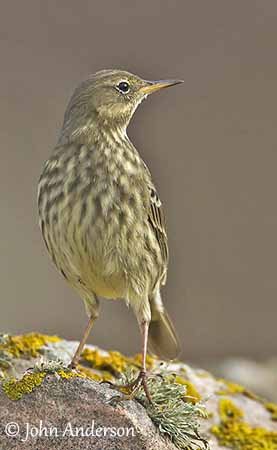
SUBSPECIES AND RANGE:
The Eurasian Rock Pipit has 3 recognized subspecies.
A.p. kleinschmidti is found on Faeroes and outlying Scottish islands of Shetland, Orkney, Fair Isle and St Kilda, off W Scotland. This race is yellower below with very wide streaks, and paler above.
A.p. petrosus (described above) occurs on the coasts of Ireland, Britain (except SE), Channel Is and N & NW France.
A.p. littoralis breeds on the coasts of Fennoscandia and NW Russia. It winters S from S Scandinavia along the W European coasts and NW Africa. This race has more conspicuous eyebrow than nominate race. The upperparts are greyer and the breast is washed pinkish with little or no streaks.

HABITAT:
The Eurasian Rock Pipit nests near the rocky coasts and on islands with low vegetation. It may occasionally nest inland, like on St Kilda, or close to freshwater lakes according to the range.
It winters on rocky shores, near saltmarshes, in estuaries, or sometimes inland, near freshwater lakes and rivers.
This species winters on the coasts of W Europe. It is mostly resident in Ireland, England and France, but populations from Scandinavia and Russia migrate southwards in winter.
CALLS AND SONGS: SOUNDS BY XENO-CANTO
The Eurasian Rock Pipit utters a sharp, musical song. The contact call is a metallic, loud “fiist”. The typical song in flight is a single, rising “wiist”, often repeated several times and monotonous. The alarm call is a sharp “stip” or tseut”.
Songs are given from elevated rock or while flying. They are loud and musical, including twittering trills.
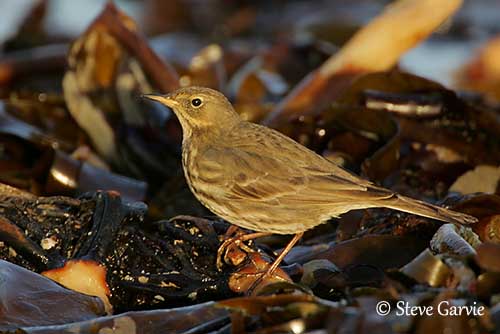
BEHAVIOUR IN THE WILD:
The Eurasian Rock Pipit is almost exclusively a coastal species, feeding among rocks, grasses and vegetation on the shores. It pecks on stones and seaweeds. It walks and runs on the ground thanks to its long legs, but it rarely hops.
It feeds on large amount of invertebrates including terrestrial snails and slugs, annelids, and crabs, crustaceans and small fish. It also takes insects and seeds.
On the wintering grounds in Netherlands, the Eurasian Rock Pipit feeds almost exclusively on molluscs Assiminea grayana, a small conical shell. In Norway, it feeds primarily on crustaceans. During winter, it may feed on more than 15,000 small molluscs and larvae every day.
The Eurasian Rock Pipit is usually solitary and territorial, but during winter, they form groups or larger flocks and are more gregarious. This species is often resident and does not move far from its territory. It is often perched on prominent rocks, or in small groups pecking on the shorelines.
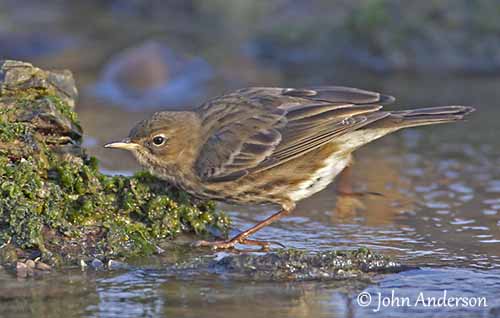
During the breeding season, the Eurasian Rock Pipit can be territorial. For sedentary birds, territory defence is performed all year round. Pairs are usually monogamous, but the race “littoralis” is sometimes polygynous.
Aerial displays are observed. The male rises into the air (15-30 metres) while singing, and then descends in parachute-flight action with semi-open wings and dangling legs for soft landing. This flight is accompanied by series of harsh notes ending in twittering trills.
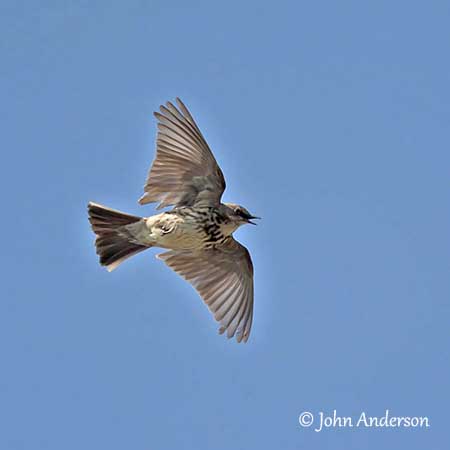
The nominate race is primarily resident with only some short movements. The race “littoralis” is mostly migratory and move S after breeding, and winters on coasts, as far as SW Europe and even Morocco for some birds. The race “kleinschmidti” can be seen near inland lakes and rivers, but not so far from the coast.
The Eurasian Rock Pipit appears really stocky-bodied in flight. But during the song-flight, it is powerful and agile.
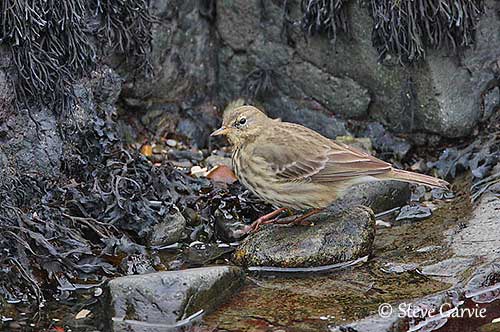
REPRODUCTION OF THIS SPECIES:
The Eurasian Rock Pipit breeds between mid-March and August depending on the range.
The cup-shaped nest is built by the female with dried grass, leaves and seaweeds, and the lining is made with animal hair or softer materials. It is placed in crevice or small cavity among rocks. It is often near the shore, in sheltered hollow or below rock or vegetation, on shore or grassy slope.
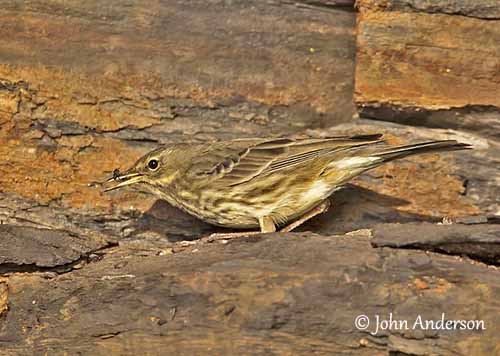
The female lays 4-5 white and grey eggs with brown spots. This species usually produces two broods in the southern parts of the breeding range. The incubation lasts about two weeks by the female, while the male guards the surrounding of the nest. The chicks are reared by both parents. They fledge 15 days after hatching and scatter around. They are independent two weeks later.
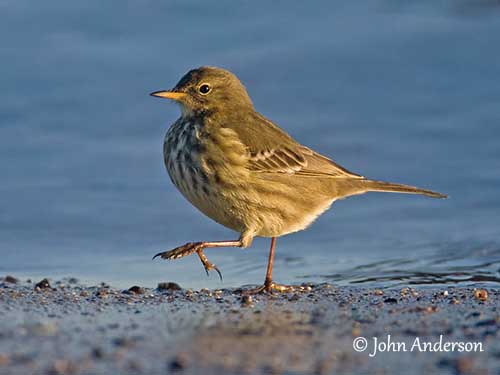
PROTECTION / THREATS / STATUS:
The Eurasian Rock Pipit is common in the wide range. The population appears to be stable because the habitat is currently still untouched. However, oil pollution on the rocky coasts may temporarily reduce the prey availability.
The breeding population in Europe is estimated to number 110 000/290 000 pairs, equating to 330 000/870 000 individuals (2004).
Currently, the Eurasian Rock Pipit is evaluated as Least Concern.
